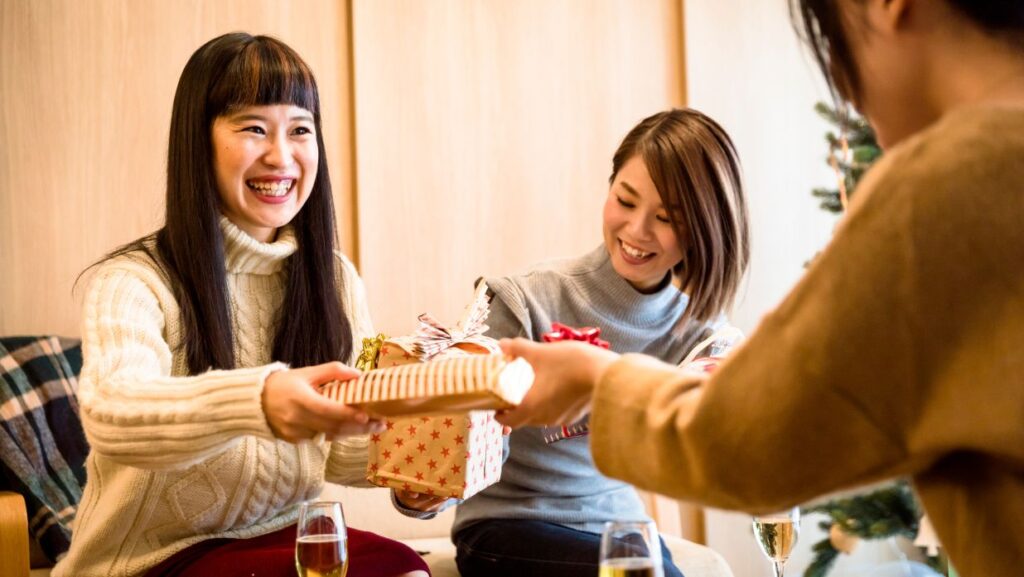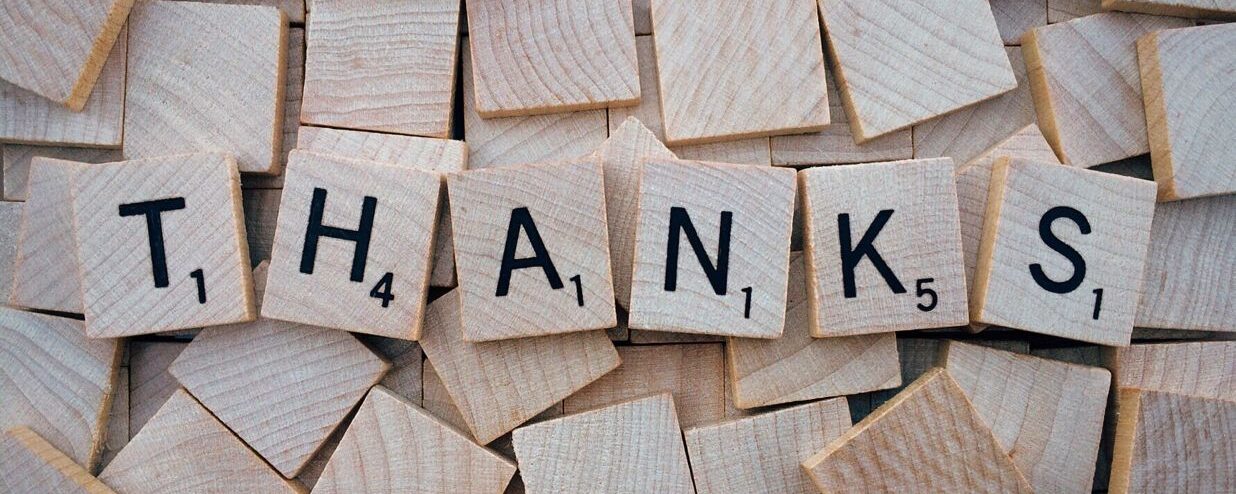Gratitude and appreciation for the little things are deeply rooted in Japanese culture, but did you know that saying “thank you” in Japanese isn’t as simple as it seems?
Depending on who you’re speaking to, the phrase you use can change significantly. And we’re not just talking about the difference between “arigatou” and “arigatou gozaimasu.” For example, the way you thank a friend differs from how you thank a client. The social proximity and status between the speaker and the degree of politeness determine the best manners and phrases to use. From the formal kansha shimasu to the English loanword that’s popular among young men, sankyuu, every situation calls for a different “thank you”.
But don’t worry! Here’s a practical guide to 20 different ways to say “thank you” in Japanese. We’ll break down when to use each phrase (and when not to), explain the nuances behind them, and give you example situations so you can express gratitude naturally in Japan.
What is Thank You in Japanese?
The most basic and commonly used way to say “thank you” in Japanese is 「ありがとうございます」(arigatou gozaimasu). However, Japanese is a language rich in nuance and politeness, so there are several variations of the phrase depending on the level of formality, the situation, and who you are speaking with.
Kanji for Arigatou(ありがとう)
The kanji for arigatou is 有り難い. The word was originally used in Buddhism, where 有る (aru) means “existing; being”. If you’ve learned a few kanji, you will probably be familiar with the second character, 難, which is also used for the Japanese adjective muzukashii (難しい), which means “difficult”.
Here, 難い comes from gatou (難う), which carries the same meaning (muzukashii) and is derived from the Japanese adjective “difficult.”
Together, they both can be translated to “something that rarely exists,” “difficult to have,” or “something rare and precious.“
Think of the phrase arigatou as a Japanese proverb: Having someone do something for you is a rare and precious thing.
Now, the word arigatou is often written in hiragana. ありがとう or, if you’re familiar with the more formal and long way to say thank you, ありがとうございます (arigatou gozaimasu).
History of Arigatou(ありがとう)
It’s interesting to look at the kanji characters that trace their historical roots back to the 8th Century.
According to the kokugo dictionary (national dictionary), arigatashi originally meant “difficult to exist”, which later had its meaning changed to “something rare”. It wasn’t until the 15th century that it eventually came to mean welcome or thankful.
Culture of Saying Thank You in Japan
Japanese culture and way of living are reflected in its language. Different pronouns, honorific titles and verb forms are used depending on the relationship between speaker and listener, ranging from downright rude to the utmost respect.
Similar to saying sorry, expressing the basic arigatou gozaimasu (ありがとうございます) is tightly related to the Japanese culture of groupthink, humility and compassion. In Japan, people try to put the priority of their in-group (uchi) ahead of their own personal desires.
Ironically, one “ありがとうございます” in a Japanese work setting can come off as curt and insincere. Instead, say thanks a second time is necessary to show one’s sincere feelings of appreciation for receiving a kind gesture.
For example, instead of saying “Thank you for waiting,” Japanese people might opt to say “Sorry for keeping you so long.” They might not necessarily seek forgiveness, but this apology is a token of politeness and humility.
This is because “thank you” and “sorry” fits nicely with one another — or, at least, in Japan’s structured society. Sometimes, it seems like a few minutes of Japanese thank-yous amongst a group of recipients will last an eternity.
Keep in mind that in formal writing and business situations, the word can be written as either 有り難う or 有難う followed by ございます.
It’s perfectly acceptable and quite common in business situations to say thank you in its hiragana form as ありがとうございます. And if you feel really appreciative of what you have received, you can add どうも or おおきに to the beginning of the previous word.
Casual and Everyday Ways to Say Thank You in Japanese

1. Sankyuu (サンキュー)
Sounds familiar? The word sankyuu is a loanword taken too literally from the English phrase “thank you”. The Japanese alphabet doesn’t recognize the consonant “th, so the “s” is used (full table on converting English to Japanese consonants here).
And because it’s a loanword, it means it’s written in katakana, too. There are typically two written versions: サンキュー (with a long “u” vowel sound at the end) and サンキュ (with a short “u” vowel).
It goes without saying, but never use サンキュー to someone socially higher or older than you. Only use this on your friends whom you are close to, as even saying it to a same-aged classmate or colleague can give the wrong impression of being “too friendly”.
Most of the time, this casual way of saying thank you in Japanese is used by young Japanese people.
2. Azassu (あざっす)
Sankyuu is a loan word, but azassu is a popular Japanese slang. The word actually comes from the original ありがとうございます. If you try saying it fast, you’ll notice that you’re going to skip some vowels and consonants. That’s how azassu was born.
This is one of the slang words that are popular among Japanese men. In the same way saying ore sounds more rough and masculine, あざっす has a light and casual tone. It can be written as あざーす、あざーっす or あざす. It depends on the length of the vowel you might want to emphasize.
3. Azamasu (あざます)
Another branch of the same slang word above, あざます is popular among young people in Japan. Other variations include ざす(zasu) and あざお(azao). You’ll notice that men tend to use these slang words more often than women, too.
4. Doumo (どうも)
Domo and arigatou tend to have similar formality levels expressed in quite casual situations. Domo is used more often by male speakers and is less often heard among Japanese women.
It’s a quick, shortened way to say thank you to your friends or family if you don’t want to use slang words. Keep in mind that, rank-wise, doumo is more casual than the shortened arigatou. Because of this, save this for someone who has the same social status, if not lower than you.
This phrase for saying thank you is extremely casual. It’s an even more casual way to say thank in Japanese than “arigatou”. Because of its extreme light tone, this phrase is often used with people at the same social status level as you or lower, like your friends and younger siblings. It’s also okay to say it to the cashier or restaurant staff.
5. Sumimasen (すみません)
すみません (Sumimasen) literally means “excuse me” or “sorry,” but in Japanese it’s also commonly used to say thank you, especially when someone has gone out of their way to help you or do you a favor. This expression conveys a mix of gratitude and a slight feeling of apology for causing trouble or inconvenience.
For example, if someone holds the door open for you or helps you carry something heavy, saying sumimasen shows you appreciate their effort while acknowledging you might have caused them a little extra work.
Sometimes, sumimasen is even more natural than just saying “thank you” directly.
6. Sumanai (すまない)
You know how “azasu” is a slangy, shortened version of “arigatou gozaimasu”? Well, “sumanai” works the same way for “sumimasen.” It’s an informal, rougher-sounding way to say sorry or even thank you, depending on the context.
You’ll often hear guys using it more than girls, but it’s not a gendered phrase. It just carries a slightly tougher or blunt tone. Like with most casual Japanese slang, this one’s best reserved for close friends or peers. Definitely don’t use it with your boss or in any formal situation!
7. Arigatou (ありがとう)
Arigatou is really an archetypical way to express a friendly-casual thank you in Japanese. Arigatou has an identical meaning to the English “thanks”, which means that you probably know that it shouldn’t be used in formal situations.
However, because it’s less casual than doumo, you can still use it with someone older than you, like your senpai, parents or ojiisan. Keep in mind that, while it’s acceptable, the most important thing is the relationship distance you have with them.
8. Arigatou gozaimasu (ありがとうございます)
Adding gozaimasu signifies an even more formal situation, the distance between the speakers and is typically used in business encounters. It shows respect and politeness. You can also use this form for strangers, like a waiter, the konbini clerk or a distant acquaintance.
Notice sometimes people switch between the present and past tense of arigatou gozaimasu? You say arigatou gozaimashita (ありがとうございました) when someone has already helped or done a favor.
For example, if someone is offering a hand to carry your luggage, you will use the present tense.
荷物を持ってくれてありがとうございます。
Nimotsu o motte kurete arigatou gozaimasu.
Thank you for carrying my luggage.
However, if that person has carried the luggage yesterday, you’d opt for arigatou gozaimashita instead.
昨日, 荷物を持ってくれてありがとうございました。
Kinou, nimotsu o motte kurete arigatou gozaimashita.
Thank you for carrying my luggage yesterday.
9. Doumo arigatou gozaimasu (どうもありがとうございます)
In this case, adding doumo on the front emphasizes your appreciation further and makes it more polite. Besides that, you can use hontou ni (本当に), which means truly.
本当にありがとうございます。
I am truly thankful.
10. Doumo arigatou ( どうも ありがとう)
This expression is a small step up from a simple “arigatou,” but it’s a bit more casual and friendly than “arigatou gozaimasu.” It’s best used with friends, family, or younger people to show your gratitude in a warm, informal way. “Doumo” by itself can also be used casually, but we’ll cover that shortly.
11. Kurete arigatou (~くれてありがとう)
~くれてありがとう is used when you want to say “thank you for [doing something]” and attach a verb to show what action you’re thankful for. It’s commonly used in casual situations with friends, family, or people close to you. Use this structure when you’re directly thanking someone for an action they did for you or someone in your inner circle.
To use it, attach it to the て-form of a verb, which acts like a “connector” in Japanese grammar.
手伝ってくれてありがとう
Tetsudatte kurete arigatou
Thanks for helping me.
How to Say Thank You in Business Japanese

Now that we’ve gone over some casual and everyday ways to express appreciation in Japanese, let’s shift to how to say thank you in professional or workplace settings. These phrases are typically reserved for office communication and are especially common in business emails. Using them for everyday situations might come across as overly formal or stiff.
12. Kansha shimasu (感謝します)
This is usually used in business emails, more often written than spoken, as you can come off as stiff or “old-school” if you attempt to say it. The word kansha (感謝) means thanks or gratitude, which is, of course, the same as the other thank-yous above, but it has a more polite tone to it.
In business Japanese emails, you can start off with itsumo sapoto shiteitadaki, kansha shimasu (いつもさーポッとしていただき、感謝します), which means “thank you for your continued support”
You will need to add the verb する after the end. If you want to level up the formality and flex your business Japanese skill, you can use Japanese keigo instead and follow the typical rule of adding a prefix on the noun and changing する to its humble form: いたす.
The highest degree you can get from using 感謝します as an alternative to arigatou gozaimasu is ご感謝いたします (gokansha ita shimasu).
心の底からご感謝いたします。
Kokoro no soko kara gokansha ita shimasu.
I thank you from the bottom of my heart.
13. Osoreirimasu (恐れ入ります)
Lastly is the most formal phrase 恐れ入ります (おそれいります), used to thank someone for the trouble they went through to help you. The word osore (恐れ) means uneasiness, reverence or concern.
Like sumimasen, 恐れ入ります doesn’t translate immediately as “thank you” in Japanese. Even Japanese people don’t use it often, as it’s only used in super formal situations like in meetings. You can think of this phrase as something like, “Would you be so kind?”
Unlike sumimasen, which can be used as an apology, osoreirimasu is used to only acknowledge the trouble someone has done for you.
恐れ入りますが、私手紙を出してくれませんか?
Osoreirimasuga, watashi tegami o dashitekuremasenka?
Would you be so kind as to post my letter?
14. Arigataki shiawase (ありがたき幸せ)
We can’t help but sneak this one in. If you’ve never heard of it before, that’s completely understandable. Arigataki shiawase is an old-fashioned way used by Japanese samurai to show gratitude to their lord. If you like to watch Japanese historical drama, you’ve probably come across it a few times.
Now, some people still like to use it in a sarcastic way. It is sometimes used as an old-fashioned expression with humor when you catch a person doing something they don’t usually do.
まさか、お弁当を作って下さるなんて、誠にありがたき幸せにござります。
Masaka, obentou o tsukutte kudasaru nante, makoto ni arigataki shiwase ni gozarimasu.
No way… I am very grateful and happy that you made me a lunchbox.
15. Haisha moushiwagemasu ( 拝謝申し上げます)
“拝謝申し上げます” is a very polite and formal way to express gratitude. It is often used in business settings or formal written communication to show deep respect and sincere thanks to the other person.
The meaning is similar to saying, “I humbly express my heartfelt thanks” or “I sincerely offer my gratitude.” This Japanese thank you phrase uses keigo, with an implied meaning that you are putting yourself socially below the person you are thanking.
16. Otsukare sama desu (おつかれさまです)
This isn’t technically an official way to say “thank you” in Japanese, but otsukaresama desu (お疲れ様です) is a versatile phrase widely used in the workplace. It carries several meanings—it can be a greeting, a way to say “good job,” or a polite way to express appreciation for someone’s effort. In many cases, it functions as a congratulatory or thankful phrase.
For example, you might say it after finishing a presentation with a coworker or to thank someone for sending out an important email. It’s a go-to phrase for acknowledging and appreciating someone’s hard work in a professional setting.
17. Itadaite arigatou (~いただいてありがとうございます)
いただいてありがとうございます is a very polite and formal way to say “thank you for giving me [something]” in Japanese. It uses the humble verb いただく, which means “to receive,” typically used when you’re talking about receiving something from someone of higher status or when you want to sound respectful.
The phrase is formed by taking the て-form of いただく (いただいて) and attaching ありがとうございます, the polite form of “thank you.” This construction is commonly used in business settings, emails, or formal conversations to express gratitude for something you’ve been given, such as a message, a reply, or documents.
For example, you might say ご連絡をいただいてありがとうございます to mean “Thank you for contacting me.”
Saying Thank You When Eating in Japan

While you can always say arigatou gozaimasu to thank someone for the food, did you know that Japanese dining etiquette has specific phrases to use depending on whether you are about to start or have just finished your meal?
18. Itadakimasu (頂きます)
Itadakimasu is a polite phrase traditionally said before eating a meal in Japan. While it literally means “I humbly receive,” it carries a much deeper cultural meaning. Saying itadakimasu is a way of expressing gratitude, not just to the person who prepared the food, but also to the farmers, animals, plants, and everyone involved in bringing the meal to the table.
Though there’s no direct equivalent in English, it’s sometimes compared to saying “Let’s eat” or “Bon appétit.”
19. Gouchisousama deshita (ごちそうさまでした)
Gochisousama deshita (ごちそうさまでした) is the standard phrase you say after finishing a meal in Japanese to thank the person who prepared, treated, or served the food. Literally, 馳走 once meant “to run about” (as in going to great lengths to prepare a feast), so the phrase conveys appreciation for all the effort behind the meal.
Don’t get mistaken between itadakimasu and gouchisousama deshita! Itadakimasu is said before you eat the food. Gouchisousama deshita is said after you finish eating!
Bonus: Bowing to say Thank You in Japanese
Showing appreciation in Japan isn’t always about words—nonverbal gestures like bowing, or ojigi, play a huge role in expressing gratitude and respect. Bowing is a tradition that dates back over 1,000 years and remains an essential part of Japanese culture today.
Typically, bowing is done from the waist with a straight back. The angle of your bow conveys how humble or respectful you are being: a slight 15-degree bow is casual and common for everyday situations, such as acknowledging a shopkeeper. A deeper 30-degree bow is more formal and often used in professional settings, like greeting clients or coworkers. The deepest bows—around 45 degrees—are reserved for expressing deep gratitude, sincere apologies, or when meeting someone very important.
Of course, if someone just did you a small favor, you don’t need to perform a formal bow. A quick nod or a brief bow can still effectively show your sincerity and thanks.
How to Use Sumimasen and Arigatou in Context
If you live in Japan, you’ll probably realize that sumimasen might as well be Japanese people’s favorite word. That’s because すみません is a versatile word with multiple meanings, ready to be used across different social contexts. It can be said in situations where the English “excuse me” and “sorry” would fit.
遅くてすみませんでした!
Osokute sumimasen deshita!
I’m sorry for being late!
すみません、通ります。
Sumimasen, toorimasu.
Excuse me, I’m going through.
Check out: Apologizing in Japanese
Besides these two functions, sumimasen can be used to express gratitude for someone who’s gone through all the trouble helping us. Think of the word as “sorry for being a nuisance.” In other words, when you’re thanking someone, you’re also making a fuss or bothering them. You thank them for allowing you to inconvenience them. This is why, oftentimes, “thank you” goes hand in hand with “I’m sorry”.
Because of this, Japanese people actually use sumimasen a lot more than arigatou. For example, instead of being grateful that someone is holding the elevator for you, you’d say sumimasen. In this case, you’re implying, “Sorry (but thank you) for holding the elevator for me.”
Sumimasen and arigatou don’t have to be used separately, though. You can combine domo, sumimasen and arigatou together when speaking Japanese.
Occasionally, you can attach the word wazawaza (わざわざ ), which means “purposefully”. When you do, it emphasizes your appreciation for bothering someone.
わざわざ、すみません。ありがとうございます。
Wazawaza, sumimasen. Arigatou gozaimasu.
どうも、すみません、ありがとうございました。
Doumo, sumimasen, arigatou gozaimashita.
Conclusion
And there you have, a quick guide on how the Japanese use all these permutations to specifically show their appreciation and thanks based upon the situation at hand. Pay particular attention to the situation for which you have been thanked, and you will gradually develop a greater sensitivity to how the expression “thank you” is properly used in Japanese. If you want to learn more, why not join Japanese lessons in Tokyo, or practice with an online Japanese tutor with Coto Academy?
Fill out the form below for a free level check and get a personalized recommendation by our friendly staff!
FAQ
What is the most common way to say thank you in Japanese?
The most common way is 「ありがとうございます」(arigatou gozaimasu). It’s polite and appropriate in most situations, especially when speaking to people you don’t know well.
What does ありがとう (arigatou) mean?
「ありがとう」(arigatou) is a casual way to say “thank you” in Japanese. It’s typically used with friends, family, or people of the same age or lower status.
What's the difference between arigatou and arigatou gozaimasu?
Arigatou is casual and best for informal situations, while arigatou gozaimasu is more polite and respectful. Use the polite version when talking to someone older, in a professional setting, or with people you don’t know well.
Is it rude to only say arigatou?
It’s not rude if you’re speaking casually with friends or people you know well. But in formal or unfamiliar settings, it’s better to use arigatou gozaimasu to sound more polite and respectful.
Learning Japanese? You might be interested in:
